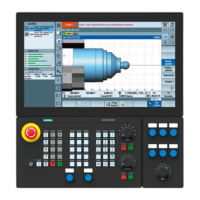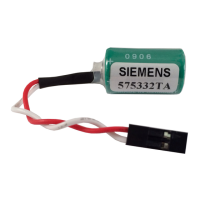Path traversing behavior
9.1 Tangential control (TANG, TANGON, TANGOF, TANGDEL)
Job planning
Programming Manual, 03/2006 Edition, 6FC5398-2BP10-1BA0
9-5
Example of the tangential follow-up with automatic optimization
Automatic optimization using Dist and angle tolerance
N80 G0 C0 ;Y1 is geometry axis 2
N100 F=50000
N110 G1 X1000 Y500
N120 TRAORI ;Rounding with axial tolerance
N130 G642
N171 TRANS X–Y– ;Automatic optimization of path veloc.
N180 TANG(C,X,Y, 1,,"P") ;Rounding path 5 mm,
N190 TANGON(C, 0, 5.0, 2.0) ;Angle tolerance 2 degrees
N210 G1 X1310 Y500 ;Activation of the follow-up with 2nd def.
N215 G1 X1420 Y500
N220 G3 X1500 Y580 I=AC(1420)_
J=AC(580)
N230 G1 X1500 Y760
N240 G3 X1360 Y900 I=AC(1360)_
J=AC(760)
N250 G1 X1000 Y900
N280 TANGOF(C)
N290 TRAFOOF
N300 M02
Defining following axis and leading axis
TANG is used to define the following and leading axes.
A coupling factor specifies the relationship between an angle change on the tangent and the
following axis. Its value is generally 1 (default).
Limit angle using the working area limitation
For path movements, which oscillate back and forth, the tangent jumps through 180° at the
turning point on the path and the orientation of the following axis changes accordingly.
This behavior is generally inappropriate: The return movement should be traversed at the
same negative offset angle as the approach movement.
This is done by limiting the working area of the following axis (G25, G26). The working area
limitation must be active at the instant of path reversal (WALIMON).
If the offset angle lies outside the working area limit, an attempt is made to return to the
permissible working area with the negative offset angle.

